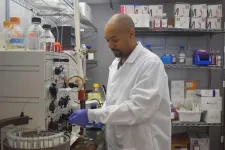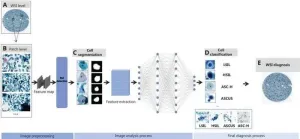(Press-News.org) TUCSON, Arizona — A researcher at the University of Arizona College of Medicine – Tucson received a $1.9 million grant from the National Institutes of Health to continue his research into uncovering the mysteries of copper – specifically, how it can be harnessed to kill harmful bacteria and other microorganisms.
“We started using copper tens of thousands of years ago to cut down on bacterial infections,” said Michael D.L. Johnson, PhD, an associate professor of immunobiology. “People used to store their food in copper pots, which helped cut down on spoilage. Copper doorknobs have been shown to cut down on hospital-acquired infections. We’re still finding more things it can do.”
Johnson said he hopes one of these potential new uses could form the backbone of a next-generation antibiotic; however, to build a solid foundation for the pharmaceutical research, his lab aims to learn more about what makes copper toxic to bacteria in the first place. The research is being made possible by an R35 grant, which is reserved for scientists with outstanding research records and the potential to make major contributions to their fields.
Using Streptococcus pneumoniae as a model organism, Johnson and his team will attempt to learn what makes bacterial cells vulnerable to copper.
“It’s a pretty prominent pathogen. More than a million people die per year because of these bacteria,” he said, referring to the bacteria that can cause infections in the lungs, brain, nose and blood. “Our laboratory is interested in trying to figure out how it ticks. Our way of doing that is to understand how it gets its nutrition.”
The human body uses minerals such as iron and calcium, which we get from our diets, to keep bodily processes running. Bacteria are no different in that they need minerals to function, but copper, which is essential in the human diet, can be toxic to bacteria.
“There are certain minerals that bacteria don’t want in excess, and that’s where copper comes into play,” said Johnson, who is a member of the BIO5 Institute. “There are a lot of ways we can weaponize copper. We’re trying to study how our body uses copper as a mechanism to kill pathogens.”
Johnson believes that by flooding bacteria’s environment with excess copper, researchers may be able to trick them into building essential proteins with the wrong materials.
“Copper can displace iron, manganese or other metals and inactivate the protein,” he said. “It would be like me trying to start my wife’s car with my key. It doesn’t work.”
Johnson will build on his previous studies investigating how S. pneumoniae reacts to copper and complement parallel studies performed in his lab to learn more about copper as an antimicrobial. He said his goal is to untangle exactly what makes copper toxic to S. pneumoniae and use that information to draw conclusions about similar bacteria.
“All bacteria are different, but there are some mission-critical systems that are the same from bacteria to bacteria. How they process some of these metals is almost identical,” he said. “What I’m studying can be applied to other bacteria, but first we need to understand the basic mechanism of how these things work.”
Johnson said that while new antibiotics are slow to be developed and approved, antibiotic resistance is on the rise among pathogens, meaning that infections that were once easily cured with medicine could someday be deadly again. The Centers for Disease Control and Prevention considers antibiotic resistance a danger to public health, with drug-resistant S. pneumoniae classified as a “serious threat.”
“Bacteria are quite crafty. They will mutate to overcome antibiotics,” Johnson said.
“Our bodies have evolved to use copper to kill bacteria, and to this day, copper is still toxic. We want to take advantage of that to help people with life-threatening infections.”
This research is supported by the National Institute of General Medical Sciences, a division of the National Institutes of Health, under award no. R35GM128653.
END
$1.9M NIH grant will allow researchers to explore how copper kills bacteria
With antibiotic resistance on the rise, a University of Arizona College of Medicine – Tucson laboratory is on a mission to discover new ways to neutralize harmful microorganisms.
2025-01-10
ELSE PRESS RELEASES FROM THIS DATE:
New fossil discovery sheds light on the early evolution of animal nervous systems
2025-01-10
Embargoed until Friday 10-Jan-2025 14:00 ET (10-Jan-2025 19:00 GMT/UTC)
An international team of scientists has uncovered a fascinating piece of the evolutionary puzzle: how the ventral nerve cord, a key component of the central nervous system, evolved in ecdysozoan animals, a group that includes insects, nematodes, and priapulid worms. Their findings, published in Science Advances, provide valuable insights into the origins of these structures in the basal Cambrian period.
The research team, comprising Dr Deng Wang (Northwest University), Dr Jean Vannier (Université ...
A battle of rafts: How molecular dynamics in CAR T cells explain their cancer-killing behavior
2025-01-10
HOUSTON – (Jan. 10, 2025) – A study published in Science Advances shares new insights into how two of the most common types of chimeric antigen receptor (CAR) T cells kill cancer. Investigators from Baylor College of Medicine, Texas Children’s Cancer Center and the Center for Cell and Gene Therapy at Baylor, Houston Methodist Hospital and Texas Children’s Hospital examined how molecular dynamics at the immune synapse – where CAR T cells bind to cancer cells – affect anticancer activity.
In this study, researchers aimed to understand how CAR T cells with different signaling domains work at the molecular and cellular levels to lay the ...
Study shows how plant roots access deeper soils in search of water
2025-01-10
Scientists have discovered how plants adapt their root systems in drought conditions to grow steeper into the soil to access deeper water reserves.
Plant scientists from the University of Nottingham, in collaboration with Shanghai Jiao Tong University, have identified how abscisic acid (ABA), a plant hormone known for its role in drought response, influences root growth angles in cereal crops such as rice and maize. The results have been published in Current Biology.
The study highlights how ABA and auxin, another key hormone, work together to shape root growth ...
Study reveals cost differences between Medicare Advantage and traditional Medicare patients in cancer drugs
2025-01-10
A new study examining the use of high-cost drugs among patients with colorectal cancer and non-small cell lung cancer found those insured through Medicare Advantage received less expensive cancer drugs compared to others on Traditional Medicare.
The findings were published today in JAMA Health Forum.
"Lung cancer is the leading cause of cancer-related deaths in the United States and colorectal cancer ranks third. Gaining a better understanding of treatment options and their costs under different insurance plans is important for assessing the overall healthcare landscape and how insurances manage patient costs,” said the study’s first author Cathy Bradley, PhD, Dean ...
‘What is that?’ UCalgary scientists explain white patch that appears near northern lights
2025-01-10
A whitish, grey patch that sometimes appears in the night sky alongside the northern lights has been explained for the first time by researchers at the University of Calgary.
The article, which was published on Dec. 30 in the journal Nature Communications, explores a “structured continuum emission” that’s associated with aurora borealis.
“You’d see this dynamic green aurora, you’d see some of the red aurora in the background and, all of a sudden, you’d see this structured – almost like a patch – grey-toned or white toned-emission connected to the aurora,” says Dr. Emma Spanswick, ...
How many children use Tik Tok against the rules? Most, study finds
2025-01-10
How many children use Tik Tok against the rules? Most, study finds
As the U.S. Supreme Court considers whether Congress can ban Tik Tok, new research highlights the health risks that top social media platforms pose to children.
Most 11- and 12-year-olds use Tik Tok and other social media despite the platforms’ age restrictions, and many show signs of addiction to social media, a new UC San Francisco study found.
Tik Tok, Instagram, YouTube, and Snapchat require users to be at least 13 years old to have an account. But the study found that a majority of 11- and 12-years olds across the country have accounts on the platforms, ...
Scientists find out why aphasia patients lose the ability to talk about the past and future
2025-01-10
An international team of researchers, including scientists from the HSE Centre for Language and Brain, has identified the causes of impairments in expressing grammatical tense in people with aphasia. They discovered that individuals with speech disorders struggle with both forming the concept of time and selecting the correct verb tense. However, which of these processes proves more challenging depends on the speaker's language. The findings have been published in the journal Aphasiology.
Aphasia is a severe speech disorder, often resulting ...
Tickling the nerves: Why crime content is popular
2025-01-10
Consumers of content about serial killers watch and read it to experience intense emotions that are often lacking in everyday life and to understand the reasons that drive people to commit crimes. However, such content does not contribute to increased aggression. These conclusions were drawn by sociologists from HSE University. The results of their study have been published in Crime, Media, Culture: An International Journal.
Research on the modern media market shows that content about serial killers is popular worldwide, spanning films, true crime series, short videos, and written materials detailing crimes, investigations, ...
Intelligent fight: AI enhances cervical cancer detection
2025-01-10
A cutting-edge article is paving the way for a transformation in cervical cancer screening, leveraging artificial intelligence (AI) to enhance detection accuracy and efficiency. This pioneering research explores the application of AI in medical image interpretation, marking a significant leap in cervical cancer management and prevention. With the aid of deep learning algorithms, the study seeks to address the critical need for more effective screening tests, especially in low- and middle-income countries where traditional methods often fall short. This innovative approach promises to alleviate the global burden of cervical cancer by improving ...
Breakthrough study reveals the secrets behind cordierite’s anomalous thermal expansion
2025-01-10
Cordierite, a remarkable mineral familiar to many as the material behind heat-resistant pizza stones, exhibits an unusual ability to resist changes in size despite significant temperature fluctuations. While widely used in diverse applications from automotive catalytic converters to high-temperature industrial processes, the fundamental reasons behind this anomalous thermal behaviour have remained largely unexplained. A new study, led by researchers at Queen Mary University of London and published in Matter, now provides the first comprehensive explanation, with profound implications for the design and development of advanced materials.
"Modern society demands materials that ...
LAST 30 PRESS RELEASES:
The Ceramic Society of Japan’s Oxoate Ceramics Research Association launches new international book project
Heart-brain connection: international study reveals the role of the vagus nerve in keeping the heart young
Researchers identify Rb1 as a predictive biomarker for a new therapeutic strategy in some breast cancers
Survey reveals ethical gaps slowing AI adoption in pediatric surgery
Stimulant ADHD medications work differently than thought
AI overestimates how smart people are, according to HSE economists
HSE researchers create genome-wide map of quadruplexes
Scientists boost cell "powerhouses" to burn more calories
Automatic label checking: The missing step in making reliable medical AI
Low daily alcohol intake linked to 50% heightened mouth cancer risk in India
American Meteorological Society announces Rick Spinrad as 2026 President-Elect
Biomass-based carbon capture spotlighted in newly released global climate webinar recording
Illuminating invisible nano pollutants: advanced bioimaging tracks the full journey of emerging nanoscale contaminants in living systems
How does age affect recovery from spinal cord injury?
Novel AI tool offers prognosis for patients with head and neck cancer
Fathers’ microplastic exposure tied to their children’s metabolic problems
Research validates laboratory model for studying high-grade serous ovarian cancer
SIR 2026 delivers transformative breakthroughs in minimally invasive medicine to improve patient care
Stem Cell Reports most downloaded papers of 2025 highlight the breadth and impact of stem cell research
Oxford-led study estimates NHS spends around 3% of its primary and secondary care budget on the health impacts of heat and cold in England
A researcher’s long quest leads to a smart composite breakthrough
Urban wild bees act as “microbial sensors” of city health.
New study finds where you live affects recovery after a hip fracture
Forecasting the impact of fully automated vehicle adoption on US road traffic injuries
Alcohol-related hospitalizations from 2016 to 2022
Semaglutide and hospitalizations in patients with obesity and established cardiovascular disease
Researchers ‘listen in’ to embryo-mother interactions during implantation using a culture system replicating the womb lining
How changing your diet could help save the world
How to make AI truly scalable and reliable for real-time traffic assignment?
Beyond fragmented markets: A new framework for efficient and stable ride-pooling
[Press-News.org] $1.9M NIH grant will allow researchers to explore how copper kills bacteriaWith antibiotic resistance on the rise, a University of Arizona College of Medicine – Tucson laboratory is on a mission to discover new ways to neutralize harmful microorganisms.





